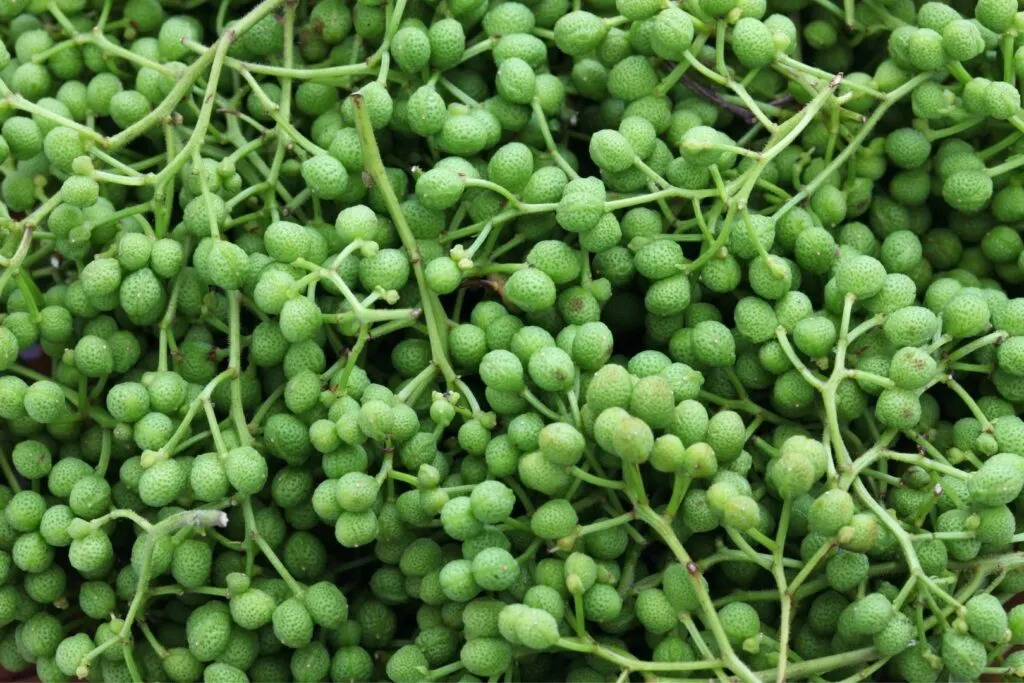Do you think that Japanese food isn’t spicy? Think again.
Japanese cuisine features a number of spicy condiments, from wasabi and hot mustard, to chili oils, powders and pastes. And while they may differ in terms of the type of spiciness – for example, wasabi is a different kind of spicy from that of a chili, and also different from how sansho pepper is spicy – there are many ways to add heat to your next meal.
In this article, we’ll introduce you to 7 spicy Japanese condiments and seasonings that will have you re-evaluating the assumption that Japanese cuisine lacks a hot punch.
Table of Contents
Wasabi
Wasabi (山葵, わさび) is a green paste famous for being served with sushi and sashimi and native to Japan. In Japanese we describe the sensation it provides as “a sting going through the nose”.

Fresh real wasabi is used grated, but is famously hard to come by as it only grows in shaded fresh water springs. Wasabi also comes in tubes as well as powder form which is mixed with water to produce a paste.
It is similar to horseradish, and in fact, sometimes horseradish is used in making wasabi pastes, albeit a substitute for the real thing. Wasabi pastes made out of Japanese wasabi are sometimes referred to as “hon-wasabi” (real-wasabi) (本わさび, ほんわさび) to distinguish them from pastes made out of horseradish.
Karashi (Japanese mustard)
Karashi (芥子, からし) or Japanese mustard is a yellow paste made out of the powdered seeds of Brassica juncea. It is not mixed with anything else, and thus is stronger and more pungent than other Western mustard-condiments which may be mixed with sugar, vinegar and other spices.

The Wa-karashi (和からし, わ・からし) that has been traditionally eaten in Japanese cuisine is sold in powder form and is used by dissolving the powder in water. It has a very strong smell compared to karashi that comes in tubes or those that are called Neri-karashi (練りからし, ねり・からし), which normally have additives in order to stabilise them and make them last, as well as to recreate the pungent smell.
In Japanese cuisine, you will notice that small packs of karashi often accompany natto packages, shumai dumplings and gyoza. It is also often used as a condiment to accompany oden.
Karashi-su-miso (からし酢味噌, からし・す・みそ), which is a sauce made of white miso, vinegar, sugar and karashi, is used to create a dish called Nuta, which can consist of vegetables, seaweed or seafood mixed with this sauce.
Togarashi (chili)
In Japan it is quite rare to find fresh chili peppers being sold, usually the spicy ones are sold dried, and are a red variety called Taka-no-tsume (鷹の爪, たか・の・つめ) meaning “hawk talons”. Some sweeter chilis, such as mild Shishito peppers and sweet Manganji peppers, are often sold fresh.
Tōgarashi (唐辛子, とうがらし) specifically is the Japanese name for Capsicum annuum, a red pepper native to Central and South America. It is frequently presented in the form of bottles of Shichimi togarashi (chili with seven spices) or ichimi togarashi (just chili) in soba and udon shops throughout Japan.
Shichimi togarashi is a popular spice blend that includes such ingredients as dried chili, sansho pepper, hemp seeds, sesame seeds, mikan citrus peel, shiso (perilla leaves), poppy seeds, aonori seaweed and ginger. Along with being a popular way to spice up soba and udon, it is also used for ramen, gyudon, tonjiru and other Japanese soups.

The word Togarashi itself means Karashi that came from abroad. Tō ( 唐, とう) means China in many contexts, but in this case it indicates it is a foreign product. It is said that chili came to Japan by way of Portuguese missionaries who had brought it back from Brazil. In 1542, a Portuguese missionary presented it to the then Daimyō (feudal lord), Ohtomo Yoshishige.
Sansho
Sanshō (山椒, さんしょう) is a plant native to Japan. It gives you a distinct numbing sensation similar to Szechuan pepper, but it is a different variant.

The fiery flavor is most pronounced in the mature peppercorns. The powdered form, called Kona-zanshō (粉山椒, こな・ざんしょう), is often used as a spice to top unagi-no-kabayaki (grilled eel), yakitori or to spice up ramen, and is also an ingredient in Shichimi togarashi.
The immature green berries of the plant are called Ao-zanshō, (青山椒, あお・ざんしょう) and used as tsukuda-ni (a dish simmered in soy sauce) or cooked with small fish (chirimen-jako) to create a rice topping called Chirimen-zanshō, a popular souvenir from Kyoto.

The sansho plant’s young shoots and leaves called Ki-no-me or Ko-no-me (木の芽, きのめ/このめ) are used to garnish grilled fish and soups.
Rayu (chili oil)
Rāyu (ラー油,らーゆ) is a condiment where red chili flakes are infused in sesame oil. It is often seen at ramen shops and also used along with soy sauce to dip gyoza dumplings in.

In recent years, a new type of product called Taberu-rāyu (食べるラー油, たべる・らーゆ) (chili oil for eating) was introduced, and has become popular. It is milder than regular Rayu, has chunks of garlic and is used as a topping for rice.
Yuzukosho
Yuzukoshō (柚子胡椒, ゆずこしょう) is a green citrusy chili paste made of fermented yuzu peel and green chili, from Kyushu.
Koshō (胡椒, こしょう) normally means black pepper, but in this case it is a Kyushu dialect term referring to chili pepper. It can also be made from red chilis which produces an orange paste rather than a green one.

It is popular to put Yuzukosho on grilled meat like yakitori, or grilled fish, as well as nabe dishes, and oden, but personally I like to put it on everything!
Kanzuri
A specialty of Niigata, Kanzuri (かんずり) is a red chili paste that has a deep sweet and spicy miso-like flavor. It is made by exposing the chili to snow, then it is mixed with kōji, salt and yuzu, then fermented for 3 years.

It was originally a local condiment native to the Joetsu area, but since 1966 it has been patented by the company Kanzuri Co. LTD. and most products on the market are from them.
It is a bit of a spectacle to see the red chilis laid out in the white snow during the making process. It is used in a similar way to Yuzukosho.

What’s your favorite of these spicy Japanese condiments?
Pin me for later

Madoka Suganuma is a freelance qualitative market researcher and a cultural insights analyst based in Tokyo with an expertise in Food & Beverages.
Having split her time between Europe and Tokyo in her formative years, Madoka is on a mission to uncover and provide insight into Japanese culture and people. Madoka enjoys learning about different cultures through food and hopes that readers can have fun learning about Japanese food culture through Japanese Food Guide.

Kaori
Tuesday 8th of March 2022
I love Shichimi and Rayu, but now I'm curious about Kanzuri!
Shamalee
Wednesday 23rd of February 2022
Great read, Madoka! I would love to try Yuzukoshō.